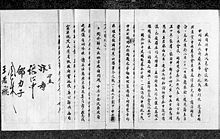Double Tenth Agreement
| Double Tenth Agreement | |||||||||
|---|---|---|---|---|---|---|---|---|---|
 A copy of the original agreement published in the Jiefang Ribao | |||||||||
| Traditional Chinese | 雙十協定 | ||||||||
| Simplified Chinese | 双十协定 | ||||||||
| |||||||||
| Summary of Conversations Between the Representatives of the Kuomintang and the Communist Party of China | |||||||||
| Traditional Chinese | 政府與中共代表會談紀要 | ||||||||
| Simplified Chinese | 政府与中共代表会谈纪要 | ||||||||
| |||||||||
The Double Tenth Agreement, formally known as the Summary of Conversations Between the Representatives of the Kuomintang and the Communist Party of China, was an agreement between the Kuomintang (KMT) and the Communist Party of China (CPC) that was concluded on 10 October 1945 (the Double Ten Day of the Republic of China) after 43 days of negotiations.[1][2] Mao Zedong and United States Ambassador to China Patrick J. Hurley flew together to Chongqing on 27 August 1945 to begin the negotiations. The outcome was that the CPC acknowledged the KMT as the legitimate government, while the KMT in return recognised the CPC as a legitimate opposition party. The Shangdang Campaign, which began on 10 September, came to an end on 12 October as a result of the announcement of the agreement.[3]
The agreement was signed at what is now the Red Rock Village Museum in Chongqing.
See also
References
- ^ Liu, Shaoqi (1991). Selected Works of Liu Shaoqi, Vol. I. Foreign Languages Press. p. 456. ISBN 0835111806.
- ^ "中国共产党大事记 1945年 (Record of major events of the Communist Party of China)" (in Chinese). The Central People's Government of the People's Republic of China. 2007-08-30. Retrieved 2008-01-09.
- ^ Yang, Benjamin (1997). Deng: A Political Biography. M. E. Sharpe. pp. 98–99. ISBN 1563247216.
